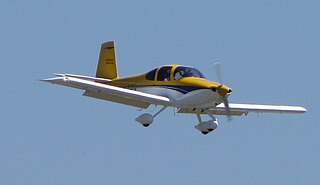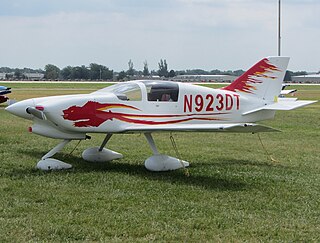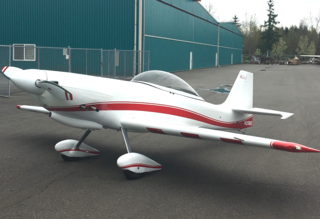
The Van's RV-4 is an American light homebuilt aircraft supplied in kit form by Van's Aircraft of Aurora, Oregon. It seats two people in a tandem seating configuration with the pilot accommodated in the front seat.

The Van's Aircraft RV-10 is a four-seat, single-engine, low-wing homebuilt airplane sold in kit form by Van's Aircraft. It is the first four-seat airplane in the popular RV series. The RV-10 first flew on 29 May 2003, and the first kit parts were delivered to a customer in September 2003.

The Van's RV-8 is a tandem two-seat, single-engine, low-wing homebuilt aircraft sold in kit form by Van's Aircraft. The RV-8 is equipped with conventional landing gear, while the RV-8A version features tricycle landing gear. The design is similar to the earlier RV-4, although it is larger than that earlier model.

The Maule M-4 is an American four-seat cabin monoplane designed by Belford Maule and built by the Maule Aircraft Company.

The Maule M-5 is an American four-seat cabin monoplane designed and built by the Maule Aircraft Company.

The Team Tango Tango 2 is an American low-wing composite homebuilt aircraft, marketed as a kit for amateur construction by Team Tango of Williston, Florida.

The KIS TR-4 Cruiser is a four place composite homebuilt aircraft design.

The Backcountry Super Cubs Mackey SQ2 is an American STOL amateur-built aircraft, designed and produced by Backcountry Super Cubs of Douglas, Wyoming. The aircraft is based upon the design of the Piper PA-18 Super Cub and is supplied as a kit for amateur construction.
The Sawyer Skyjacker II is an American homebuilt aircraft that was designed and produced by Ralph V. Sawyer of Lancaster, California, in 1974. It first flew on 3 July 1975. The aircraft was intended as a research project and as such only one was built.
The Adventure Air Adventurer is a family of American homebuilt amphibious flying boats that was designed and produced by Adventure Air of Berryville, Arkansas. When it was available the aircraft was supplied as a kit for amateur construction. The company appears to be out of business.

The Aircraft Technologies Acro 1 is an American aerobatic homebuilt aircraft that was designed by Fred Meyer and produced by Aircraft Technologies of Lilburn, Georgia. When it was available the aircraft was supplied as a kit or in the form of plans for amateur construction. Neither plans nor kits are available anymore and the aircraft is out of production.
The Giles G-200 is an American aerobatic homebuilt aircraft that was produced by AkroTech Aviation of Scappoose, Oregon. When it was available the aircraft was supplied as a complete ready-to-fly-aircraft or a kit for amateur construction. The first customer-built aircraft made its first flight on May 26, 1996. AkroTech Aviation went out of business and the design is no longer in production.

The Brutsche Freedom 40 was an American homebuilt aircraft that was designed by Neal H. Brutsche and produced by Brutsche Aircraft Corporation of Salt Lake City, Utah. The aircraft was intended to be supplied in the form of plans for amateur construction, with a partial kit available.
The CEI Free Spirit Mk II, also called the Cabrinha Free Spirit Mark II and the Cabrinha Model 423, is a three-seat American homebuilt aircraft that was designed by Richard Cabrinha and produced by CEI of Auburn, California, introduced at AirVenture in 1995. The aircraft was intended to be supplied as a kit for amateur construction, but only prototypes seem to have been completed.
The Express Series 90 is an American homebuilt aircraft that was designed and produced by the Express Aircraft Company of Olympia, Washington, introduced in the late 1980s. When it was available the aircraft was supplied as a kit for amateur construction.
The Glassic SQ2000 is an American homebuilt aircraft, designed and produced by Glassic Composites LLC of Sale Creek, Tennessee. When it was available the aircraft was supplied as a kit for amateur construction.
The Ultimate 10-200 is a Canadian homebuilt aerobatic biplane that was designed produced by Streamline Welding of Hamilton, Ontario, introduced in the 1990s. When it was available the aircraft was supplied as a kit or in the form of plans for amateur construction.
The Washington T-411 Wolverine is an American homebuilt aircraft that was produced by Washington Aeroprogress of Seattle, Washington, introduced in the 1990s. When it was available the aircraft was supplied as a kit or in the form of plans for amateur construction.
The American Homebuilts John Doe is an American STOL homebuilt aircraft that was designed by Steve Nusbaum and produced by American Homebuilts of Hebron, Illinois, first flown in 1994. When it was available the aircraft was supplied as a kit for amateur construction.
The Ibis GS-750 Grand Magic is a Colombian homebuilt aircraft, designed and produced by Ibis Aircraft of Cali, introduced in 2006. The aircraft is supplied as a complete ready-to-fly-aircraft or as a kit for amateur construction.










